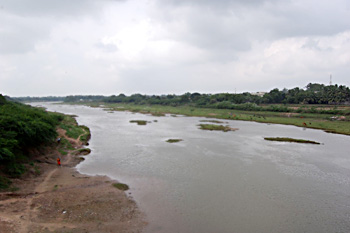 Development of trade under Nayaka administration is amply borne out by the Vijayanagar inscriptions of the sixteenth century. The frequent references to Pattadai, Tari, Pettai, Kaikkolas, Vaniyas, Sekku-Vaniyas, Kanmalas, etc., are testimony to this phenomenon, which seems to have started in the fourteenth century or even earlier, judging from the appearance of many of these terms in fourteenth and fifteenth century inscriptions. The condition of the economy greatly improved under the Nayakas as they continued with the process of development that had begun in the fourteenth century. The Nayakas drew artisans and merchants into the framework of their rule. They gave them great encouragement and protection, as is evident in the tax remission given to Kanmalas, and the Talarikkam collected from the weekly fair. These processes must have been closely linked to the development of foreign trade. These processes must have been closely linked to the development of foreign trade.
Development of trade under Nayaka administration is amply borne out by the Vijayanagar inscriptions of the sixteenth century. The frequent references to Pattadai, Tari, Pettai, Kaikkolas, Vaniyas, Sekku-Vaniyas, Kanmalas, etc., are testimony to this phenomenon, which seems to have started in the fourteenth century or even earlier, judging from the appearance of many of these terms in fourteenth and fifteenth century inscriptions. The condition of the economy greatly improved under the Nayakas as they continued with the process of development that had begun in the fourteenth century. The Nayakas drew artisans and merchants into the framework of their rule. They gave them great encouragement and protection, as is evident in the tax remission given to Kanmalas, and the Talarikkam collected from the weekly fair. These processes must have been closely linked to the development of foreign trade. These processes must have been closely linked to the development of foreign trade.
Instances have been found of the donation of Pattadai-Nulayam, which is the tax paid in cash by people who lived in Pattadai (artisan workshops). Though there is a bit of confusion regarding who exactly fell into this category of `Pattadai`, it is generally held to include Kaikollas and other artisans as well as merchants. The Kaikkolas were weavers who increased their influence remarkably in Vijayanagar times. Apart from the Kaikkolas, there were Settis (merchants), Sekku-Vaniyas (oil merchants), and Koliyas (weavers) who also paid the Pattadai-Nulayam. Others who paid the Pattadai-Nulayam include Ilai Vaniyas (betel-leaf sellers) and three groups of Kanmalas, i.e. Kollans (blacksmiths), Tachchans (carpenters) and Tattans (goldsmiths), besides some other communities. This diversity of artisan and merchant communities itself shows the increased importance of these professions.
The references to the Pettai (market) and Vara-Sandai (weekly fair), are all related to the assignment of income or revenue accruing from them to some temples. The establishment of a new street in Chidambaram by Muttu Krishnappa Nayaka should also be understood in the context of the development of trade and commerce in the sixteenth century. This development is apparent not only from the frequent appearance of terms relating to communities of artisans and merchants and the revenue collected from them, but also from the privileges given to some of these communities. The records of the grant of tax remission to Kanmala communities by the government and local powers shows their increasing influence in the central part of South Arcot District by virtue of the professional skills and unity of the whole Kanmala community. Similarly, there are records of the privileges given to Kaikkolas towards the end of the fifteenth century.
Another instance of the development of trade is the grant by Kondama Nayaka to the Perumparrappuliyur temple of the commission on the pepper trade (Milagu Taragu) due from six localities (Parru) along the Vellar River. This must have been related to the development of foreign trade in the sixteenth century. An inscription from Kugaiyur in South Arcot talks about the compulsory cultivation of sugar-cane in the upper valley of the Vellar River in the latter half of the fifteenth century, which may also be linked to the development of foreign trade, since sugar was an important export of the time and the locality was on the trade route between South Arcot and Kerala.
The temples have also played a rather important role in the development of trade. The Kaikkolas, being closely associated with temples, were often induced to work within the temple precincts (Tirumadaivilagam). There is plenty of historical evidence of this practice and their association with temples seems to date back even earlier. Their association with the Devaradiyars who worked in temples is also noteworthy. The appearance of Kaikkola-Mudalis among members of the temple management is the outcome of their long and close association with the temple. Not only Kaikkolas, but other Pattadai people were also induced by temple authorities or other local leaders to come and settle in the temple precincts or temple villages. The association of artisans and merchants with temples must have been responsible to a great extent for the development of temples in Vijayanagar times, which explains in turn the Nayakas` desire for associating themselves with temples. Thus the development of trade under Nayakas, closely associated with the temples, was quite considerable.






































